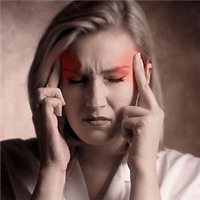Types Of Migraines

A migraine headache is a chronic mild to severe symptoms, including pounding, light sensitivity and nausea. In some cases, nausea and vomiting, mild to severe. The duration can be anything from minutes to 48 hours. Headaches with both men and women aged 10 and 46 but they are more common in women and run in families. Stressors that create brain activity and irregular blood vessels constrict often trigger vascular headaches. Stress factors include alcohol, pungent odor, glare, smoking, hormones, interference of the environment, stress and diet. The attack begins in the brain and disrupts the flow of blood into the brain tissue and its surroundings. A headache is not an indication of a brain tumor.
Migraine types are commonly categorized according to the regularity of the type and the origin of the types of headaches. The seven types of headaches are:
1) Abdominal Migraine or periodic syndrome predominantly diagnosed in children. In addition, there is a family medical history of such symptoms.
2) Acephalgic or eye migraine often has no head pain and is associated with visual disorientation, vertigo, and queasiness.
3) Migraine without Aura (warning) is a common headache with no warning symptom prior to the illness.
4) Migraine with Aura appears in three different forms: a) with a warning symptom, for instance vision problems, prior to the onset or b) familial hemiplegic migraine or c) sporadic hemiplegic migraine.
5) Familial hemiplegic and sporadic hemiplegic are migraines with aura and motor limitations. A migraine is classified as familial if a close family member suffers from this type of migraine as well.
6) A basilar artery migraine is an uncommon variety of headache with aura. A basilar artery migraine usually appears in young adults. This type of illness is often mistaken for intoxication because during the migraine, the person has garbled speech, disorientation, and body tingling.
7) A retinal migraine occurs in one eye and is an indication of the possible presence of a serious medical condition. If this occurs, see your doctor.
Some migraine sufferers experience four parts to their migraine attack. The parts are called: 1) the prodrome occurring before the migraine headache; 2) the aura leads the headache; 3) the migraine or headache; and 4) the postdrome or aftermath sensations. The sensations may vary from a feeling of relief, almost euphoria, to complete exhaustion or depletion.
Unfortunately, there is no cure for migraine headaches. However, through lifestyle changes, preventive therapy and doctor prescribed medications, the frequency, and duration of migraine attacks will decrease allowing for a less restricted lifestyle. A doctor who specializes in the treatment of migraine headache types s is your best bet in the diagnoses and successful treatment of this chronic condition.
Nutrition
Why Do People Gain Weight So Quickly After Losing It?
 Slide Down || Slide Up
Slide Down || Slide Up
The Symptoms of Inflammation Can Be Deadly
 Slide Down || Slide Up
Slide Down || Slide Up
Reasons Why Water Is The Best Drink Ever
 Slide Down || Slide Up
Slide Down || Slide Up
Meal Replacement For Weight Loss: The 6 Best Ingredients
 Slide Down || Slide Up
Slide Down || Slide Up
Lose Weight With Shakeology - How Does It Work?
 Slide Down || Slide Up
Slide Down || Slide Up
Health Drinks: Experience Healthy Acai Berry Fruit Drinks
 Slide Down || Slide Up
Slide Down || Slide Up
5 Easy Ways to Cut the Fat Fast
 Slide Down || Slide Up
Slide Down || Slide Up




.jpg)








.jpg)